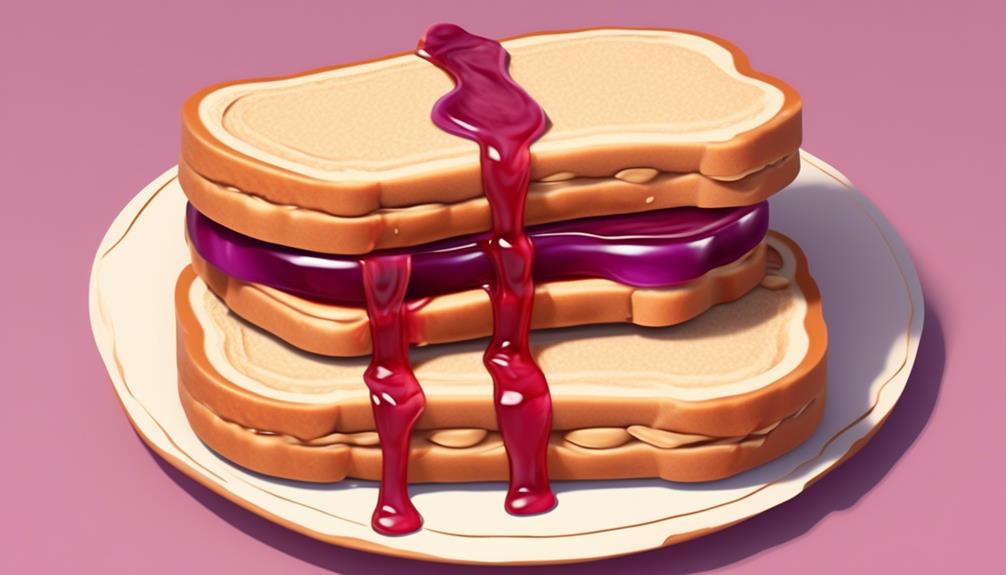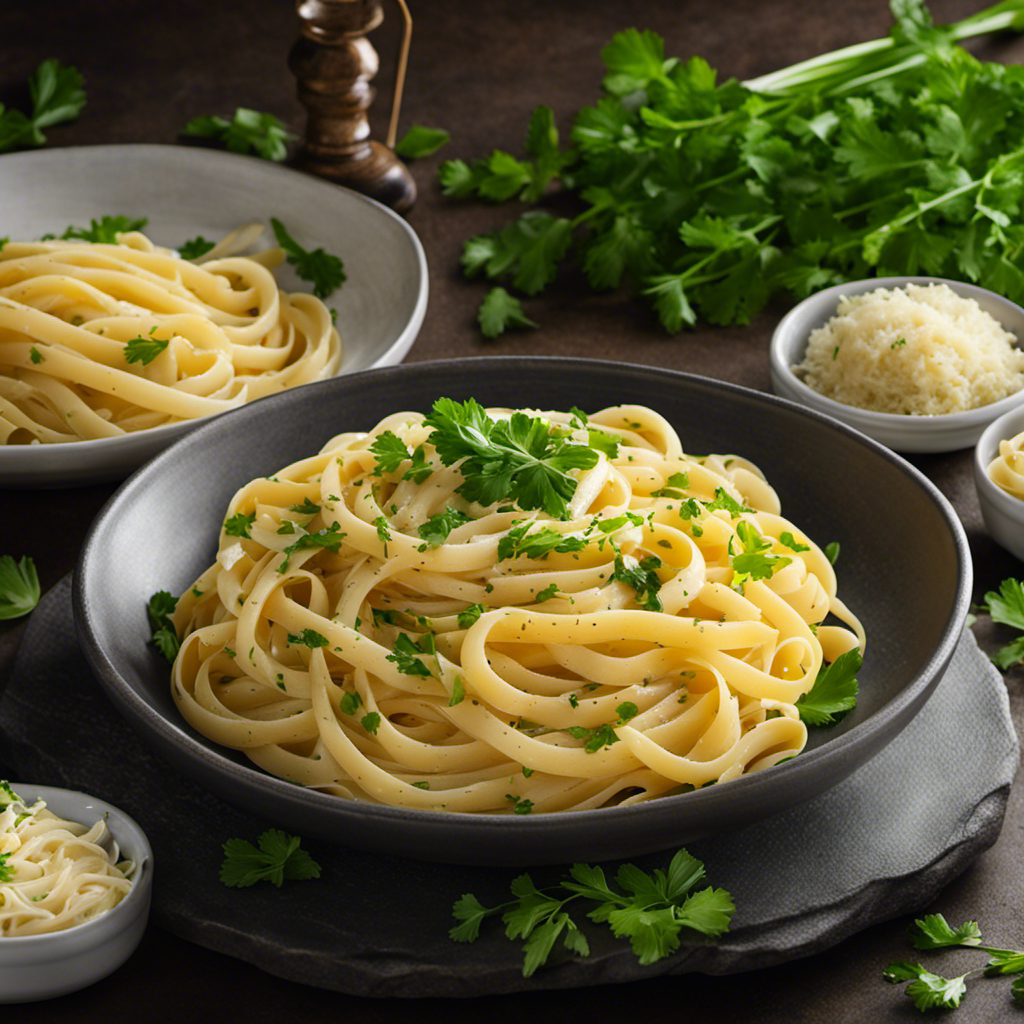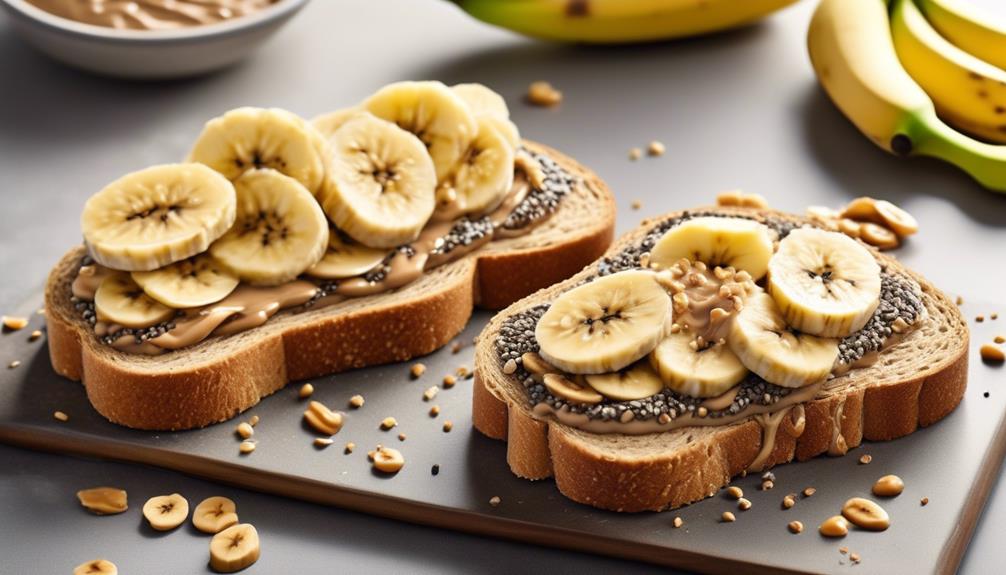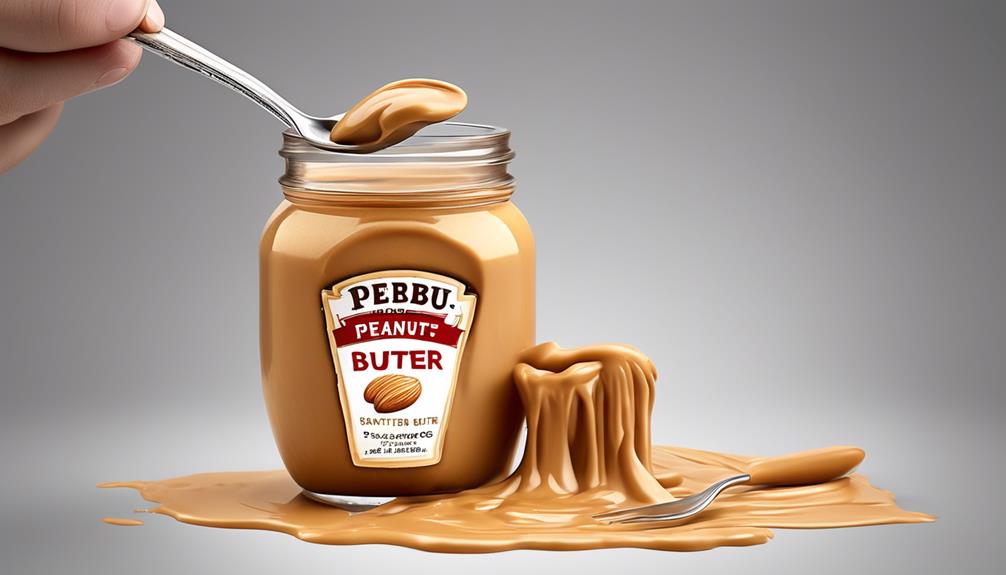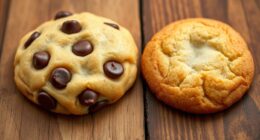When it comes to the proportion of peanut butter to jelly in a sandwich, it’s akin to the timeless argument of whether to pour milk before or after cereal. Each person has their own steadfast beliefs on what creates the ideal mix.
But have you ever wondered what really goes into determining the ideal ratio? Is it a matter of personal taste, or is there a scientific approach to achieving the perfect blend of creaminess and sweetness?
Join us as we explore the intricate balance between these two beloved spreads and uncover the secrets to crafting the ultimate peanut butter and jelly masterpiece.
Key Takeaways
- Preferences for the ratio of peanut butter to jelly vary widely, with some preferring a 50-50 balance and others leaning towards a 60-40 or 70-30 split.
- Finding the perfect balance between sweetness and creaminess is crucial, with individual taste preferences heavily influencing the ideal ratio.
- Achieving the optimal texture involves calibrating the spreadability and viscosity of the ingredients, with personal preferences for creaminess and spreadability playing a significant role.
- Personalizing the ratio is important, as some prefer a higher peanut butter ratio for a thicker, creamier texture while others enjoy a generous amount of jelly for added sweetness and moisture.
The Classic Debate
In the classic debate surrounding the peanut butter to jelly ratio, various preferences and considerations come into play, influencing the ultimate sandwich experience.
The ratio of peanut butter to jelly in a peanut butter and jelly sandwich is a topic that sparks passionate discussions. Some prefer a 50-50 balance, while others lean towards a 60-40 or 70-30 split. The choice between all peanut butter, all jelly, or a balance between the two is deeply personal, influenced by individual taste and sweetness preferences.
Grape jelly, a popular choice for this classic sandwich, adds its own dimension to the debate, with its distinct flavor and texture. The texture and taste of the sandwich are directly affected by the chosen ratio, making it a crucial factor in the overall enjoyment of the sandwich.
The debate has even extended to social media, with fans engaging in discussions and polls to determine the ideal ratio. Ultimately, finding the perfect peanut butter to jelly ratio is an endeavor that requires experimentation and a keen understanding of personal preferences to achieve that satisfying balance that makes a perfect PB&J.
Balancing Sweetness and Creaminess

Balancing the sweetness and creaminess of a peanut butter and jelly sandwich involves carefully calibrating the ratio of these key ingredients, a crucial factor that shapes the overall sandwich experience.
Finding the perfect balance between the peanut butter and jelly is essential for achieving the desired level of sweetness and creaminess. Preferences vary widely, with some favoring a 50-50 ratio for an equal blend, while others lean towards a 70-30 split to highlight the flavor of one ingredient over the other.
Our individual taste preferences and past experiences heavily influence our ideal ratio, with many opting for a 60-40 split to strike a harmonious balance.
Achieving this balance isn't only about flavor but also about texture, as it's crucial to find the perfect equilibrium between dryness and goopiness. Even though there's no definitive answer to the ideal ratio, a common suggestion is 2 to 1, emphasizing the dominance of peanut butter while still incorporating the sweetness of jelly.
Applying the ingredients evenly is pivotal in creating a sandwich that perfectly balances sweetness and creaminess to suit our personal preferences.
Texture Matters

Achieving the optimal texture in a peanut butter and jelly sandwich involves carefully calibrating the spreadability and viscosity of the peanut butter and jelly to create a harmonious balance. The texture matters significantly as it directly impacts the overall sensory experience of the sandwich.
The balance between the creamy peanut butter and smooth jelly greatly influences the mouthfeel, with experimentation and personal taste playing a significant role in finding the ideal texture. It's essential to strike the perfect balance between dryness and goopiness to ensure an enjoyable eating experience.
Personal preferences for texture, such as the creaminess of the peanut butter or the spreadability of the jelly, are key factors in determining the ideal ratio. To achieve the desired texture, one must consider the thickness and consistency of both the peanut butter and jelly to ensure that they complement each other.
Personalizing Your Ratio

To personalize your peanut butter to jelly ratio, it's essential to consider individual preferences and desired texture, allowing for a tailored sandwich experience based on personal taste and sensory satisfaction.
When personalizing the ratio of these two ingredients, making sure to understand one's own preferences is crucial. Some individuals prefer a higher peanut butter ratio for a thicker, creamier texture and a less soggy sandwich, while others enjoy a generous amount of jelly for added sweetness and a moist consistency.
Understanding the debate surrounding this topic, it's evident that personal opinions on jelly and peanut butter vary widely. From the discourse on Twitter and the preferences of different staff members, it's clear that there's no one-size-fits-all approach to this ratio.
To find the ideal ratio for oneself, it's important to experiment with different proportions and consider the desired sensory experience. Ultimately, personalizing the peanut butter to jelly ratio allows for a customized sandwich that aligns with individual taste preferences and texture expectations.
Beyond Sandwiches: Other Uses

Exploring alternative applications, peanut butter and jelly can be utilized in various culinary creations beyond the traditional sandwich, adding versatility and flavor to a range of dishes.
- French Toast Peanut Butter and Jelly Sandwiches
Create a delightful twist on the classic combo by using peanut butter and jelly as a filling for French toast. This combination offers a delectable blend of sweet and savory flavors, perfect for a breakfast or brunch treat.
- *No-Nut Butter & Jelly Muffins*
For individuals with nut allergies, incorporating no-nut butter and jelly into muffin batter offers a safe and delicious alternative. These muffins provide a convenient and portable option for enjoying the beloved flavors of peanut butter and jelly.
Achieving the Perfect Spread

Beyond sandwiches, peanut butter and jelly can be analyzed and adjusted to achieve the perfect spread, allowing for a personalized and balanced flavor experience.
Achieving the perfect spread involves a careful consideration of the peanut butter to jelly ratio. The ideal ratio varies based on individual preferences, with options such as 50-50, 60-40, or 70-30 being popular choices.
To gather insights, a Twitter discussion among fans and a poll conducted by The Takeout staff highlighted the diverse preferences in the quest for the perfect spread. Some individuals lean towards an all-peanut butter or all-jelly sandwich, while others seek a harmonious balance between the two ingredients for a satisfying flavor profile.
Experimentation and personal taste play crucial roles in determining the perfect ratio, taking into account factors such as texture and sweetness. Expert recommendations advocate for a 2 to 1 ratio of peanut butter to jelly and emphasize the uniform application of the ingredients for a well-balanced sandwich.
Ultimately, achieving the perfect spread requires a tailored approach, considering individual taste preferences and a thoughtful balance between the distinct flavors of peanut butter and jelly.
Fun Variations to Try

Let's consider the various flavor pairings that can enhance the peanut butter and jelly experience.
We'll also explore how different texture combinations can offer a new dimension to this classic sandwich.
Additionally, we'll analyze creative spreads that can take the traditional peanut butter and jelly to the next level.
Flavor Pairings
How can we enhance the classic peanut butter and jelly sandwich with creative flavor pairings? When exploring flavor pairings, it's essential to consider the balance of sweet, salty, and savory notes. Here are some fun variations to try:
- Fruit Infusions:
- Mix in slices of fresh strawberries or bananas for a burst of fruity sweetness that complements the nuttiness of the peanut butter.
- Spread a layer of raspberry jam to add a tangy twist to the traditional sandwich.
- Spiced Up Options:
- Incorporate a hint of cinnamon into the peanut butter for a warm, aromatic flavor profile.
- Experiment with a spicy jalapeño jelly to add a surprising kick to the sandwich.
Texture Combinations
Exploring texture combinations for the classic peanut butter and jelly sandwich entails considering how different textures can complement the flavor pairings we've previously discussed.
French Toast Peanut Butter and Jelly Sandwiches introduce a delightful twist with their unique texture contrast. The decision to leave the crust on or cut it off significantly impacts the sandwich's texture, with the former providing a slightly chewier border and the latter enhancing the creamy texture.
However, toasting the bread isn't recommended, as it can alter the creaminess and texture of the ingredients.
When it comes to the peanut butter, personal preference dictates the choice between crunchy and smooth, with the former adding texture and the latter being equally acceptable.
Achieving the ideal 2 to 1 ratio of peanut butter to jelly and applying the ingredients evenly is crucial for a balanced sandwich that highlights the texture combinations.
Creative Spreads
The exploration of creative spreads for peanut butter and jelly sandwiches can lead to delightful variations that enhance the overall flavor profile. When considering fun variations to try, it's important to keep in mind our preferred peanut butter to jelly ratio.
Here are some exciting spreads to experiment with:
- Different Nut Butters:
- Try almond, cashew, or hazelnut butter for a unique twist on the classic peanut butter taste.
- Experiment with varying textures and flavors to find the perfect complement to your preferred jelly ratio.
- Fruit Preserves and Spreads:
- Consider using different fruit preserves such as raspberry, apricot, or peach to add a burst of fruity sweetness to your sandwich.
- Mix and match different fruit spreads to find the perfect balance with your preferred peanut butter ratio.
Frequently Asked Questions
What Is the Perfect Ratio of Peanut Butter and Jelly?
We believe the perfect ratio of peanut butter to jelly varies based on personal preference.
Experimentation is key to finding the ideal blend.
Our team has differing opinions, with some favoring a 60-40 split.
However, athletes may opt for less peanut butter to avoid complications during physical activities.
Ultimately, the perfect ratio is subjective and depends on individual taste and texture preferences.
What Is the Best Peanut Butter to Jam Ratio?
When it comes to the best peanut butter to jam ratio, it's a matter of personal taste. We've found that a 2 to 1 ratio provides a perfect balance of flavors.
It's like finding the sweet spot in a dance routine, where both partners are in sync. This ratio ensures a delightful blend of nutty richness and fruity sweetness, creating a harmonious sandwich experience.
How Do You Make an Exact Peanut Butter and Jelly Sandwich?
We make an exact peanut butter and jelly sandwich by spreading peanut butter on one slice of bread and jelly on the other. We ensure an even layer, balancing the flavors for a satisfying bite. Experimentation is key in finding the ideal ratio, as individual preferences vary.
Our team enjoys a 60-40 split, but it's all about personal taste. The perfect sandwich is a delicate balance of dryness and goopiness, achieving the ultimate PB&J experience.
What Is the Standard Jelly for Pb&J?
We believe the standard jelly for PB&J is a personal preference.
Our technique for a perfect PB&J involves a delicate balance of flavors and textures, akin to a well-conducted orchestra.
The ideal ratio ultimately depends on individual taste and texture preferences. While some prefer a 70-30 peanut butter to jelly ratio, others may favor a more even split.
Our approach values intimacy, precision, and the art of a satisfying sandwich.
Conclusion
In conclusion, the ratio of peanut butter to jelly in a sandwich is a personal choice that can greatly impact the flavor, texture, and sweetness of the sandwich.
It's important to experiment and find the ideal ratio that suits your individual taste preferences.
Remember, at the end of the day, it's all about finding the perfect PB&J ratio to make your taste buds sing.
